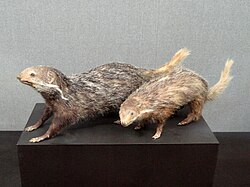| Crab-eating mongoose | |
|---|---|
 | |
| Scientific classification | |
| Kingdom: | Animalia |
| Phylum: | Chordata |
| Class: | Mammalia |
| Order: | Carnivora |
| Family: | Herpestidae |
| Genus: | Urva |
| Species: | U. urva |
| Binomial name | |
| Urva urva (Hodgson, 1836) | |
| Subspecies [2] | |
| |
 | |
| Distribution of the crab-eating mongoose | |
| Synonyms | |
Gulo urva | |
The crab-eating mongoose (Urva urva) is a species of mongoose found from the north-eastern Indian subcontinent and Southeast Asia to southern China and Taiwan. It is listed as Least Concern on the IUCN Red List. [1]

